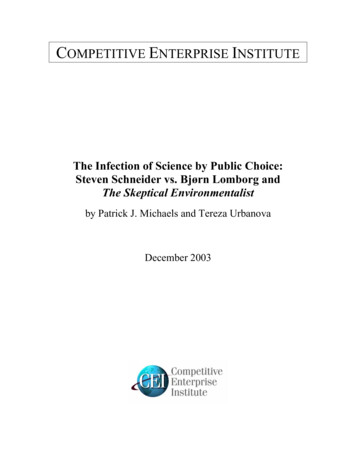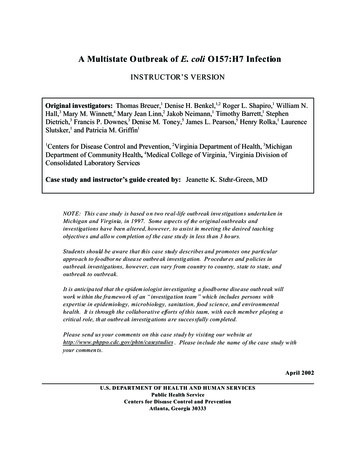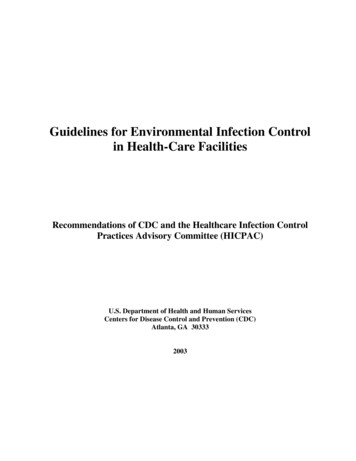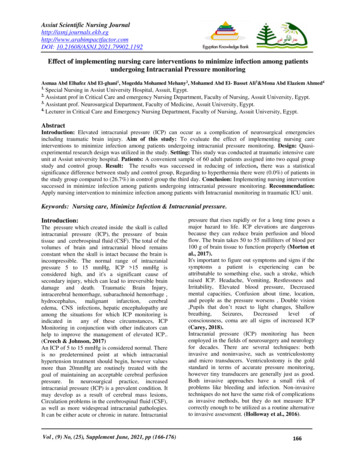
Transcription
COMPETITIVE ENTERPRISE INSTITUTEThe Infection of Science by Public Choice:Steven Schneider vs. Bjørn Lomborg andThe Skeptical Environmentalistby Patrick J. Michaels and Tereza UrbanovaDecember 2003
IntroductionMost everyone who cares about the environment in general and global warming inparticular has heard of Danish statistician Bjørn Lomborg and his book, The SkepticalEnvironmentalist, which argues that environmental threats, particularly those from globalwarming, are largely overblown. Furthermore, most people know Lomborg has sent “BigScience” into a tizzy, prompting some scientists to pen shrill screeds against him inpublications such as Nature, Science, and Scientific American. Lomborg was evenkangaroo-courted by something called the Danish “Committees [sic] on ScientificDishonesty,” which accused him of (surprise!) “scientific dishonesty.”The Danish “Committees” attacked Lomborg based on a series of unrefereed (non-peerreviewed) essays published in Scientific American, which hired four well-worn guns toshoot poor Bjørn full of holes. They included John Holdren, a Harvard University energy analyst who, along with his mentor,Paul Ehrlich, lost a 10,000 bet to economist Julian Simon in 1990 whenshortages of five metals that Ehrlich and Holdren had forecast ten years earlierfailed to materialize. Tom Lovejoy, who used to run the World Wildlife Fund, the biggestenvironmental lobbying organization in history, John Bongaarts, vice president of the Population Council, an organization that ischagrined that estimates of future population keep going down, and Steve Schneider, Department of Biology, Stanford University.Both the “Committees” and Lomborg give the most credence to Schneider’s essay,largely because it is the most literate (and vituperative) of the four, and because itconcentrates on the core environmental and lifestyle issue of our time, global warming.It’s not surprising that Schneider’s review is the nastiest. He represents academia, whichhas the most to lose if the global warming hysteria somehow dies—about 16 billion overthe next four years, the sum of money in future federal budgets proposed by PresidentBush to study this issue.While the major science journals like Science and Scientific American serve some noblepurposes, they are also susceptible to the kind of incentives explained by public choicetheory.It is no accident that the publisher of Science, the American Association for theAdvancement of Science (AAAS), is headquartered in Washington, D.C. AAAS lobbieson behalf of the research community, as do Nature and Scientific American. All threehave editorialized on behalf of the Kyoto Protocol or against President Bush’s opposition,and all have published remarkably vitriolic reviews of The Skeptical Environmentalist.
Consequently, Schneider is not alone; rather, he represents a community that recognizessubstantial economic gain from an alarmist view of global warming, a view that is simplynot warranted by scientific facts.Schneider gives his motives away in his final paragraph:“Unfortunately, angry reviews such as this one will be the result [of Lomborg’sputatively poor scholarship]. Worse still, many laypeople and policymakers won’tsee the reviews and will be tricked into thinking [Lomborg’s book] constitutesvalid scholarship.”The last paragraph of a review is ideally a coda summarizing the core ideas the writerwants to leave with the reader. Schneider’s concern is clearly that Lomborg will convincethe political community of the validity of his view, and this is why he has written such an“angry review.” Translation: I’m mad at you because you have your hand on my wallet.Schneider has a history of lacking objectivity, and a certain pride (bordering on hubris) togo with it. In 1989, concerning global warming, he told Discover magazine:“On the one hand we are ethically bound to the scientific method, in effectpromising to tell the truth, the whole truth, and nothing but which means that wemust include all the doubts, caveats, ifs and buts.“On the other hand, we are not just scientists, but human beings as well. And likemost people we’d like to see the world a better place, which in this contexttranslates into our working to reduce the risk of potentially disastrous climatechange. To do that we have to get some broad-based support, to capture thepublic’s imagination. That, of course, entails getting loads of media coverage. Sowe have to offer up scary scenarios, make simplified, dramatic statements, andmake little mention of any doubts we might have. This “double ethical bind”which we frequently find ourselves in cannot be solved by any formula. Each ofus has to decide what the right balance is between being effective and beinghonest. I hope that means being both.” [emphases added]It is staggering that Scientific American would choose Schneider as its “objective”witness against Lomborg, unless its editors were somehow unaware of this statement,which is widely cited. Everyone who has studied this issue knows this quotation.Whatever the motivation, Schneider’s record clearly makes his will “to tell the truth, thewhole truth, and nothing but” concerning Lomborg somewhat suspect. What did he leaveout? What, if left in, would have lost “broad based support,” and “the public’simagination?” The latter is a remarkable choice of words: Does Schneider feel is it therole of a scientist to stoke fearful fantasies of the untrained?
Here is the salient fact that Schneider chooses to ignore: The most consistent assemblageof observed and modeled temperatures, along with real emission rates of greenhousegases, predicts that 21st century warming is likely to be modest.Schneider’s main complaint is Lomborg’s insistence that 21st century warming will be ator near the low end of the IPCC’s range of 1.5 to 4.5ºC. Earlier, Schneider acknowledgesthat the low end is “relatively adaptable.”Pangloss’s Climate?Do we live in “the best of all possible climates?” If people could choose, what mean surfacetemperature of the planet would they select?This issue is not far beyond the horizon. J. Craig Venter, the fellow who decoded five humangenomes, recently was granted 3 million by the U.S. Department of Energy to create a bacteriumdesigned to chew carbon dioxide out of the air.Assume that Venter is successful and that people can then select the Earth’s mean surfacetemperature.Figure 1 shows the Argentiere Glacier in the French Alps in 1966. The photo is copied fromTimes of Feast, Times of Famine: Climate Since the Year 1000 by Emmanuel Le Roy Ladurie, thefirst modern book to popularize the notion that European climate is hardly stable. Figure 2 showsa woodcut of the same scene in 1850, with the glacier clearly threatening the bucolic village at itstoe. This was the European (and largely global) climate condition as the industrial revolutionbegan to mature.It is doubtful that most of us would elect to go back to that climate—the one that existed beforehumans had put much carbon dioxide in the air.What about today’s climate? The winter of 2002-03 was very cold in the northeastern U.S.;therefore, the prices of heating energy and gasoline increased (the two being somewhatinterchangeable in the refining process). In contrast, the very warm, El-Niño-driven winter of1997-98 resulted, according to an article published by this author and by climatologist StanleyChangnon, in a saving of roughly 15 billion and the prevention of approximately 850 deaths.As will be shown below, greenhouse warming primarily affects winter temperatures.Consequently, we would argue that because winters more like 1997-98 (rather than 2002-3)should become more likely, fewer people would choose the extreme temperatures we experiencedthis past winter.It seems more likely that, after considering all the positives and negatives, humans would select aclimate more like that of 4,000-7,000 years ago, when the Earth’s mean temperature wasapproximately 1.5ºC warmer than it is today. That period was known in climatic textbooks(before the current climate hysteria) as the “climatic optimum” because it accompanied the rise ofcivilization. Only the most radical of ecologists think that was a bad thing.
Most of the plants that we live with and depend upon, the Angiosperms (flowering plants),evolved on a planet that was several degrees warmer than it is today. It is therefore not surprisingthat, in general, biological productivity increases with mean surface temperature as long assufficient moisture is available.In conclusion, it seems as if people, and what people depend upon, want things a bit warmer thanthey are today.Virtually every line of evidence concerning the amount of warming points in Lomborg’sdirection and away from Schneider’s. One of the most important factors in globalwarming is the projected change in atmospheric carbon dioxide. According to Schneider:“Emissions scenarios, according to the IPCC [United Nations’ IntergovernmentalPanel on Climate Change] fall into six “equally sound” alternative paths. Thesepaths span a doubling in carbon dioxide concentrations in 2100 up to more thantripling Lomborg, however, dismisses all but the lowest of the scenarios.”Lomborg is much more likely to be correct than the IPCC high scenarios. In general,IPCC scenarios assume some type of exponential growth in carbon dioxide, and, evenmore importantly, an increase in per capita carbon dioxide emissions on a worldwidescale.Both of these assumptions—and they are the core assumptions undergirding theories ofrapid warming—have been wrong for the last quarter-century. This can be determined byexamining CO2 emissions data for increasingly long periods prior to the current year. Anexponential increase fits the data no better than a simple linear increase for the last 25years.Even more telling, carbon dioxide emissions per capita peaked in the mid-1980s and arenow declining. Statistically speaking, the downward trend, shown in Figure 3, has only aone-in-10,000 chance of being due to random variation.The six “equally sound” emissions scenarios used by the IPCC and defended bySchneider in his arguments against Lomborg produce the shaded range of warming inFigure 4. In a recently published paper in the journal Climate Research, I adjusted thesesix scenarios, using the United Nations’ own climate model and observed emission trendsin the last quarter-century. The mean expected warming for the next 100 years droppedby 40 percent, or very close to the value of 1.5 to 2.0ºC championed by Lomborg.In Scientific American, Schneider complains about Lomborg’s assertion that the “KyotoProtocol .would reduce warming in 2100 by only a few tenths of a degree,” and goeson:“This number, though is based on a straw-man policy that nobody has seriouslyproposed: Lomborg extrapolates the Kyoto Protocol, which is applicable only upto 2012, as the world’s sole climate policy for another nine decades.”
Lomborg gives Kyoto too much, not too little credit. Schneider is fully aware that themost important and widely accepted study about Kyoto’s climate impacts appeared in a1998 edition of the journal Geophysical Research Letters in response to a request fromthen Vice President Al Gore to federal scientists about Kyoto’s efficacy in mitigatingglobal warming. The paper by Tom Wigley, an outspoken advocate of restricting carbondioxide emissions, concluded that U.S. participation in Kyoto would only prevent 0.07ºCincrease in temperature in 50 years and 0.14ºC by 2100 (see Figure 5). With the U.S. outof the Protocol, these numbers drop to 0.02ºC and 0.06ºC, respectively.“Straw man” has become an increasingly abused term of the environmental Left whenthey really have no argument to make. Schneider’s statement that Lomborg is describing,“a straw-man policy that no one has seriously proposed,” has syntactical meaning.Schneider is saying that there are serious, politically viable proposals out there made bylarge numbers of people that go far beyond the Kyoto Protocol. To that we say: Show us!There aren’t any.Why the Lowest Warming Projections Are Most LikelyFigure 5, taken from a comprehensive analysis of a large suite of climate models calledthe CMIP1 study (which stands for “Climate Model Intercomparison Project”—ananalysis of 15 climate models), demonstrates that the central tendency of all of thesemodels is to a constant rate of warming, once a human-induced greenhouse warming isinitiated.There’s a very simple reason for this behavior. Laboratory experiments dating back to the19th Century demonstrate that the response of temperature to a change in a givengreenhouse gas is logarithmic—meaning that the first responses are the greatest, and thenthe warming begins to damp off at higher concentrations. But all the CMIP1 modelsassume an exponential increase in carbon dioxide, or an increasing rate of growth withtime.Addition of a logarithm and an exponent can yield straight line. It is a shame that somany billions of research dollars were spent only to prove a result that an intelligent highschool junior learns in pre-calculus.Consequently, if it can be demonstrated that human warming indeed has started, the ratebecomes defined, and we then know the amount of 21st Century warming within a smallmargin of error.In a 2000 paper in the journal Climate Research, I tested the hypothesis that humaninduced warming is occurring by examining warming rates in dry versus moist air.Greenhouse theory predicts much more warming in dry air than wet air, largely becausecarbon dioxide and water vapor absorb radiation in many of the same wavelengths in theelectromagnetic spectrum. In other words, they are largely mimics of each other, and
behaving the same, produce the logarithmic warming effect, which creates the greatestwarming when either is added to an atmosphere devoid of both.The driest places for which we have good temperature data in the last 100 years areSiberia and North America in the winter and around the Sahara Desert in the summer.Indeed, the warming is by far most pronounced in these regions, and we proved the linkto greenhouse warming in that paper by demonstrating that the more dry air there is, themore it warms. It turns out that over two thirds of the planetary warming of the last halfof the 20th century is in the winter half-year, and three quarters of that warming is in thecoldest air of Siberia and western North America.Having now established human-induced warming, how do we discriminate between allthose models in the CMIP1 study? Simple: Look out the window! We can show that therecent warming era began about three decades ago. As shown in figure 6, the observedwarming indeed is highly linear, and therefore the trend for the next 100 years is wellestablished, unless the functional form of the central tendency of all of those CMIP1models is wrong!That warming works out to about 1.6ºC over the next 100 years.This calculation first appeared in public in my 2000 book, The Satanic Gases: Clearingthe Air about Global Warming. Six months after its publication, Myles Allen and twoother co-workers from the Hadley Center, Britain’s premier climate modeling institution,adjusted their climate model with observed temperatures and produced a warming of0.75ºC in the next 50 years, or virtually the same number. Finally, in December 2001,James Hansen, the NASA scientist who is thought to have initially lit the bonfire of thegreenhouse vanities with his 1988 congressional testimony, wrote that we know “thatfuture global warming can be predicted much accurately than is generally realized.”Hansen predicted a 0.15 /- 0.05ºC increase per decade over the next 50 years, preciselythe same number calculated independently by Myles Allen and me.Why didn’t Schneider note this? One is left to hypothesize as to his motivation, notLomborg’s. But our last section may provide some insights.Public Choice and the Lomborg ControversyPublic choice theory offers some interesting insights into the vehemence of the ScientificAmerican responses to The Skeptical Environmentalist.Schneider’s rhetoric goes far beyond the contention that he simply feels that Lomborg iswrong, or is just another misinformed expert with an erroneously synthesized view ofclimate change.Instead, three paragraphs in, he describes Lomborg as a “young Danish statistician in apolitical science department.” “Young” clearly implies “inexperienced” or “naïve,”
“Statistician” has long been a pejorative among “hard” scientists, a community Schneiderbelieves he belongs to, and “political science” is about as dirty an aphorism as can begiven to anyone who in fact is writing about science.In the next paragraph, Schneider cannot resist a similar personal line: “And who isLomborg, I wondered, and why haven’t I come across him ?” The obvious translation isthat because a serious scientist like Stephen Schneider had never met Bjørn Lomborg,Lomborg must be a marginal, scientifically inconsequential figure.So, from the outset, Schneider chooses not to argue factually, and resorts immediately tothe personal pejorative. He is more interested in destroying Lomborg’s credibility than heis in deconstructing his arguments.Public choice theory offers a theoretical concept explaining patterns of behavior in suchcases. Scientists covet job security. If policy makers and the public failed to see globalwarming as a threat, then who would pay scientists for their efforts to “solve” theproblem? Simply put, public choice theory predicts that everyone responds to his or herown incentives. Scientists are no exception. After all, in Schneider’s words: “We’re notjust scientists, but human beings as well.”Scientists maintain the crucial characteristics of any interest group. Environmentalscience is an exclusive field. The community is small, and over 99.5 percent of researchfunding comes from the federal government. The community knows that there are manyother scientific research communities—cancer, heart disease, etc.—competing for thatmoney. Communities also require a shared ethic, however mythical. So, Schneider claimsthat it is up to them to make “the world a better place.”For the environmental science community, the price of such virtue is the 4.2 billion peryear proposed in the current federal budget for research on global environmental change.Competition requires that this community prove that its problem is much bigger, moreurgent, and needs more financial support than problems other interest groups want tosolve to also make the world “a better place.” The competition is not limited to otherscience and technology enterprises, but includes all federal discretionary spending, suchas housing for the homeless, another federal facility in West Virginia, and fixing theSpace Shuttle—all virtuous, all competing. Lomborg and a few other scientists (who areabout equally as popular!) threaten to derail the global warming gravy train.Public choice theory does not judge someone’s honesty or dishonesty. It simply impliesthat the structure of incentives that scientists—indeed, all individuals—face creates a biasof distortion, in which problems must be exaggerated in order to garner funding. Publicchoice is a political process—based upon rhetoric as much as fact—and Schneider’slanguage is wholly rhetorical.This political process creates a symbiotic relationship between politicians and scientiststhat works to both their advantage. Scientists get resources for their research, andresponsive politicians can tout their funding of virtuous causes. Protecting nature and
children sounds pretty virtuous. To capture 4 billion per year for climate changeresearch, it pays to scare the public a little bit. It is no accident that all of ScientificAmerican’s critics of Lomborg have considerable experience in and with Washington!We are not implying that Schneider’s intentions are bad. Regardless of intentions,scientists are still merely “sectoral experts” trying to pursue their narrow interest throughthe political process, and Schneider was behaving as a member of his interest community.Thus Schneider’s statement that there is a need to “offer up scary scenarios, makesimplified, dramatic statements, and make little mention of any doubts we might have” iseminently predictable. He is a “human being,” after all!Interestingly, the developers of public choice theory have held that science is immune toits distortions. Geoffrey Brennan and James Buchanan, in The Reason of Rules:Constitutional Political Economy, write,“Science is a social activity pursued by persons who acknowledge the existence ofa nonindividualistic, mutually agreed-on value, namely truth (Italics in original).“Science cannot, therefore, be modeled (sic) in the contractarian, or exchange,paradigm.”However, the vitriolic response to The Skeptical Environmentalist suggests that publicchoice theory explains much more than its very inventors envisioned.
Argentiere Glacier - 1966Figure 1. The Argentiere Glacier in 1966, as published in Times of Feast, Times ofFamine, by Ladurie.Argentiere Glacier - 1850Figure 2. Same as Figure 1, except for 1850, in which the glacier clearly threatens thenearby village. It seems doubtful that humans would elect to return to this pre-greenhouseclimate.
1.31.21.11Fitted Per capita.9Per re 3. Global per-capita carbon dioxide emissions have been in decline for over 20years (metric tons/person). The United Nations’ Intergovernmental Panel on ClimateChange (IPCC), which Schneider claims is more authoritative on this matter thanLomborg, assume that they have been and will continue to increase significantly. Thestatistical likelihood that the downturn is spurious is less than one in 10,000.Temperature ProjectionsAdjusted for Linear Carbon Dioxide IncreaseTemperature Change ( C)54.543.532.52A1FIA2A1 BB2A1TTAR RangeI S92 aB12.6 CT AR Range1.5 C1.51.5019902010203 0205020702090YearFigure 4. The shaded region is the IPCC range of estimates for 21st Century warming,based upon obviously wrong assumptions about increasing carbon dioxide. This graphic,taken from a recent publication in the journal Climate Research, adjusts the U.N.scenarios to emissions realities (colored lines), using their own warming model.
Predicted Global Temperature ChangeFigure 5. Central tendency of all of the climate models in the CMIP1 study, as well asthe mean warming projected by these models, if all nations of the world adopted theKyoto Protocol. The Kyoto response is taken from Wigley (1998).Figure 6. The linear warming since 1969 provides strong guidance concerning futurewarming, when compared to various model calculations. The rate works out to 1.6 C forthe next century.
ReferencesAllen, M. R., et al., 2000. Quantifying the uncertainty in forecasts of anthropogenicclimate change, Nature, 407, 617-620.Bongaarts, J., 2002. Population: Ignoring its impact, in Misleading math about the Earth,Scientific American, January 2002, 61-71.Brennan, Geoffrey and. Buchanan, James M.: The Reason of Rules: ConstitutionalPolitical Economy. [Is this a journal or monograph?] In The Collected Works of JamesBuchanan,10, Chapter 3, The Myth of Benevolence.Changnon, S. A., 1999. Impacts of the 1997-98 El Niño-generated weather in the UnitedStates, Bulletin of the American Meteorological Society, 80, 1819-1827.Hansen, J.E., Sato, M., 2001. Trends of measured climate forcing agents, Proceedings ofthe National Academy of Sciences, 98, 14778-14783.Holdren, J.P., 2002. Energy: Asking the wrong question, in Misleading math about theEarth, Scientific American, January 2002, 61-71.Ladruie, E. L. R., 1971. Times of Feast, Times of Famine: Climate Since the Year 1000,Doubleday, Garden City, NY, 426 pp.Lomborg, B., 2001. The Skeptical Environmentalist: Measuring the Real State of theWorld, Cambridge University Press, Cambridge, UK, 496 pp.Lovejoy, T., 2002. Biodiversity: Dismissing scientific progress, in Misleading math aboutthe earth, Scientific American, January 2002, 61-71.Meehl, G.A., et al., 2000. The Coupled Model Intercomparison Project (CMIP), Bulletinof the American Meteorological Society, 81, 313-318.Michaels, P.J. et al., 2000. Observed warming in cold anticyclones, Climate Research,14, 1-6.Michaels, P.J., Balling, R.C., 2000. The Satanic Gases: Clearing the Air about GlobalWarming, Cato Institute, Washington,D.C., 234 pp.Michaels, P.J. et al., 2002. Revised 21st century temperature projections, ClimateResearch, 23, 1-9.Schneider S., 1989, Quoted in Jonathan Schell, “Our Fragile Earth,” Discover, October1989, p. 47.
Schneider, S., 2002. Global warming: neglecting the complexities, in Misleading mathabout the earth, Scientific American, January 2002, 61-71.Wigley, T.M.L., 1998. The Kyoto Protocol: CO2, CH4 and climate implications,Geophysical Research Letters, 25, 2285-2288.
About the AuthorsPatrick J. Michaels is Senior Fellow in Environmental Studies at the Cato Institute. Heis also a research professor of environmental sciences at the University of Virginia andvisiting scientist with the Marshall Institute in Washington, D.C. He is a past president ofthe American Association of State Climatologists and was program chair for theCommittee on Applied Climatology of the American Meteorological Society.Michaels holds A.B. and S.M. degrees in biological sciences and plant ecology from theUniversity of Chicago, and he received a Ph.D. in ecological climatology from theUniversity of Wisconsin at Madison in 1979. He is a contributing author and reviewer ofthe United Nations Intergovernmental Panel on Climate Change. His writings haveappeared in major scientific journals, including Climate Research, Climatic Change,Geophysical Research Letters, Journal of Climate, Nature, and Science, as well as inpopular serials such as the Washington Post, Washington Times, Los Angeles Times, USAToday, Houston Chronicle, and Journal of Commerce. He has appeared on ABC, NPR's“All Things Considered,” PBS, Fox News Channel, CNN, MSNBC, CNBC, BBC andVoice of America. According to Nature magazine, Pat Michaels may be the most popularlecturer in the nation on the subject of global warming.Tereza Urbanova got her M.A. in economics from the University of Economics inPrague. Currently she works as a Research Fellow at the Liberalni Institut—the mostimportant free-market think tank in the Czech Republic. Her major interest is inenvironmental economics and free-market solutions to environmental issues. She visitedthe Cato Institute in the spring and summer of 2003 as a Research Assistant to PatrickMichaels.
Introduction Most everyone who cares about the environment in general and global warming in particular has heard of Danish statistician Bjørn Lomborg and his book, The Skeptical Environmentalist, which argues that environmental threats, particularly those from global warming, are largely overblown.











